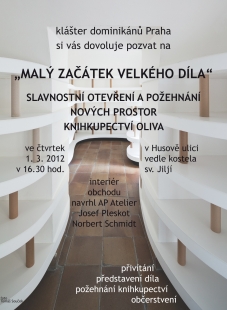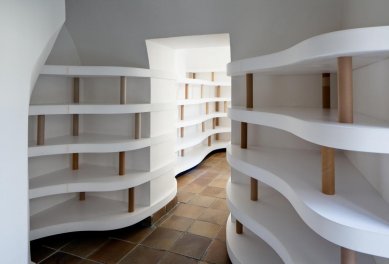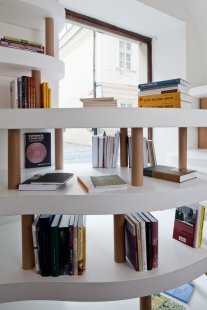
Josef Pleskot designed the new Oliva Bookstore
Prague - Exactly one week from today, on Thursday, March 1 at 4:30 PM, a new space of the Oliva Bookstore will be ceremoniously opened in the parlor of the monastery of St. Giles on Husova Street in the Old Town. On forty square meters of this sought-after bookstore focusing on spiritual and philosophical literature, all elements that will be reflected in the planned renewal of the entire domain of the Dominican brotherhood into a new cultural and educational center in Prague are concentrated. The project was created in the studio of one of the most respected domestic architects, Josef Pleskot. In agreement with heritage conservationists and members of the Dominican order, he followed several basic principles: awareness, openness, meeting, shared presence, closeness... All of this can be perceived - despite the intimate space - in the new Oliva Bookstore.
According to Josef Pleskot, the new Oliva Bookstore, which includes, for example, a fragment of the apse of the original chapel, is one of the first signs of transformation of the entire Dominican complex. A bold expression of inventive and related approach to the 17th-century monastery complex includes, for example, storage spaces for books made of paper and polystyrene custom-designed for the bookstore. Their organic shapes fill the entire intimate space of the bookstore, yet not at the expense of comprehensibility. "We sought inspiration from kaolin caves that are worn and shaped by water. We aimed for the solution to be inventive, modest, and functional," describes architect Pleskot. Additionally, the interior seemingly expands out into the street, becoming part of the life outside the bookstore. This is also intended to be perceived as evidence of the opening and revitalization of the entire complex.
"We are very grateful to the bookstore owner for embarking on this journey with us. The next stage will be the commencement of the renewal of the entire St. Giles monastery, which will gradually open to the public and offer an inspiring place for meeting, dialogue, and silence right in the center of Prague," says Benedikt Mohelník OP, provincial of the Czech Dominican province. More information can be found at www.oliva.op.cz or www.dominikanska8.cz.
The Oliva Bookstore complements the existing offerings of the monastery complex, where the space Dominikánská 8 has been successfully operating since last year. Following the example of the Parisian College des Bernardins, it serves as a meeting place for the church and civil society, the professional public, and contemporary culture. Accessible areas mainly consist of the reconstructed baroque refectory, where musical concerts, lectures, and other educational events are held several times a month.
Right on March 1, those interested can participate in a discussion meeting with the director of the Hungarian Institute in Prague, Róbert Kiss Szemán, as part of the Literary Evenings in the baroque refectory. Starting at 7:30 PM, the talk will focus on Hungarian Catholic literature. On Tuesday, March 6, a debate regarding the results of the census in the Czech Republic with regard to expressions of religiosity Did God Count His People?
The captivating atmosphere of the refectory is also ideal for musical evenings. The nearest one will take place on March 8, when harpsichordist Alena Hönigová will present a collection of six sonatas by Johann Kuhnau, a native of the Ore Mountains, with biblical motifs. Another musical evening is planned for Thursday, April 12, featuring music from the High German Baroque, specifically works by J. S. Bach, C. P. E. Bach, and G. P. Telemann. As part of the evening, which is conducted in cooperation with the Basel "Association for the Support of Graduates - Schola cantorum basiliensis," a chamber ensemble will perform, consisting of: Karel Valter - traverso, Cilka Valter - baroque violin, Ilze Grudule - baroque cello, and Marc Meisel - harpsichord.
As mentioned, the renewal of the entire complex will begin next year. Its goal is to create a space that respects the religious life of the Dominicans in the monastery while at the same time allowing activities that open the monastery to the wider public. In the bustling center of Prague, which is increasingly becoming a domain solely for tourists, a refuge will arise where both residents and visitors from farther places can find interesting new stimuli and information, meet and debate with inspiring people, or simply breathe in an environment of silence and recharge for the hectic weekdays ahead.
The project has been revised multiple times during preparations in response to archaeological surveys and consultations with heritage conservation experts. Architect Pleskot's team has met all requirements, for example, to preserve all valuable parts of the monastery and significant archaeological sites, while also breathing new life and energy into the building so that it may serve both the order and the public for centuries to come.
According to Josef Pleskot, the new Oliva Bookstore, which includes, for example, a fragment of the apse of the original chapel, is one of the first signs of transformation of the entire Dominican complex. A bold expression of inventive and related approach to the 17th-century monastery complex includes, for example, storage spaces for books made of paper and polystyrene custom-designed for the bookstore. Their organic shapes fill the entire intimate space of the bookstore, yet not at the expense of comprehensibility. "We sought inspiration from kaolin caves that are worn and shaped by water. We aimed for the solution to be inventive, modest, and functional," describes architect Pleskot. Additionally, the interior seemingly expands out into the street, becoming part of the life outside the bookstore. This is also intended to be perceived as evidence of the opening and revitalization of the entire complex.
"We are very grateful to the bookstore owner for embarking on this journey with us. The next stage will be the commencement of the renewal of the entire St. Giles monastery, which will gradually open to the public and offer an inspiring place for meeting, dialogue, and silence right in the center of Prague," says Benedikt Mohelník OP, provincial of the Czech Dominican province. More information can be found at www.oliva.op.cz or www.dominikanska8.cz.
The Oliva Bookstore complements the existing offerings of the monastery complex, where the space Dominikánská 8 has been successfully operating since last year. Following the example of the Parisian College des Bernardins, it serves as a meeting place for the church and civil society, the professional public, and contemporary culture. Accessible areas mainly consist of the reconstructed baroque refectory, where musical concerts, lectures, and other educational events are held several times a month.
Right on March 1, those interested can participate in a discussion meeting with the director of the Hungarian Institute in Prague, Róbert Kiss Szemán, as part of the Literary Evenings in the baroque refectory. Starting at 7:30 PM, the talk will focus on Hungarian Catholic literature. On Tuesday, March 6, a debate regarding the results of the census in the Czech Republic with regard to expressions of religiosity Did God Count His People?
The captivating atmosphere of the refectory is also ideal for musical evenings. The nearest one will take place on March 8, when harpsichordist Alena Hönigová will present a collection of six sonatas by Johann Kuhnau, a native of the Ore Mountains, with biblical motifs. Another musical evening is planned for Thursday, April 12, featuring music from the High German Baroque, specifically works by J. S. Bach, C. P. E. Bach, and G. P. Telemann. As part of the evening, which is conducted in cooperation with the Basel "Association for the Support of Graduates - Schola cantorum basiliensis," a chamber ensemble will perform, consisting of: Karel Valter - traverso, Cilka Valter - baroque violin, Ilze Grudule - baroque cello, and Marc Meisel - harpsichord.
As mentioned, the renewal of the entire complex will begin next year. Its goal is to create a space that respects the religious life of the Dominicans in the monastery while at the same time allowing activities that open the monastery to the wider public. In the bustling center of Prague, which is increasingly becoming a domain solely for tourists, a refuge will arise where both residents and visitors from farther places can find interesting new stimuli and information, meet and debate with inspiring people, or simply breathe in an environment of silence and recharge for the hectic weekdays ahead.
The project has been revised multiple times during preparations in response to archaeological surveys and consultations with heritage conservation experts. Architect Pleskot's team has met all requirements, for example, to preserve all valuable parts of the monastery and significant archaeological sites, while also breathing new life and energy into the building so that it may serve both the order and the public for centuries to come.
The English translation is powered by AI tool. Switch to Czech to view the original text source.



0 comments
add comment







